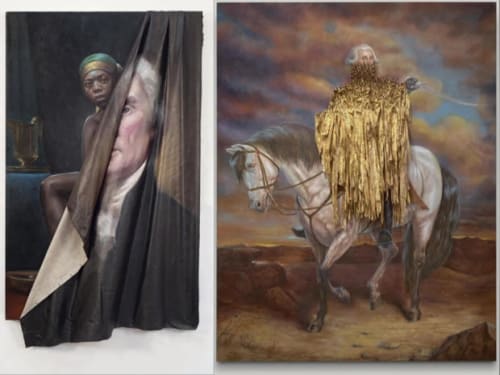The highly-anticipated show by one of the country's hottest artists was finally going up at New York's Gagosian Gallery after a six-month delay due to the Coronavirus.
But as the world kept turning, Titus Kaphar kept painting.
Correspondent Rita Braver asked, "You are doing this in the midst of all of the Black Lives Matter movement. But this is really something that you have been paying attention to for a long time."
"Most definitely," said Kaphar. "The project's reflecting things that have been happening in our community for generations."
The paintings in this series depict Black mothers, but in many of the works Kaphar has deliberately removed their children.
Kaphar said, "I think the paintings do speak to those different kinds of disappearance that happens to young Black children, that is the violence against them by police, that is being poisoned by the water in our communities, Flint, that is natural disasters that the country hasn't come up and really completely finished resolving and repairing yet."
Braver asked, "What's been the response to the painting that was on the cover, and also to the essay?"
"The only one that really matters to me is the response I got from a particular mother whose son had died, who said, 'You know, I've been looking for a symbol that represented the loss of my son. And I didn't find it 'til I saw this cover," he said.
Kaphar's work has long tackled under-representation of minorities in Western art through plays on classic paintings.
Here he superimposes a Black Jesus on a 19th-century French work:
"I wanted it to feel like an add-on," he said. "I didn't want it to feel as though it was always meant to be."
"A lot of collectors want to own your work," said Braver. "You just got, I think it was two years ago, a MacArthur 'Genius Grant.'"
"Those are true statements," he smiled.
"You almost seem disappointed by all this?"
"No, I'm not!" he laughed.
But Kaphar prefers to focus on the beginning of his story: A kid who grew up in a struggling family in Kalamazoo, Michigan, he graduated high school with a nearly failing grade point average. Then, he met a young woman (now his wife) who challenged him to make something of himself.
"Do you think she just saw something in you, that she knew that you could really become someone?" Braver asked.
"I just wanted to date!" Kaphar replied.
But he went to junior college, where he discovered art history, and soon started painting. Eventually, he got a Masters at the Yale School of Art in New Haven. He and his family now live nearby.
And Kaphar is paying it forward. In a gritty New Haven neighborhood, he convinced a list of private and public donors (including the Ford Foundation) to join him in co-founding NXTHVN, a kind of play on New Haven. "The idea has always been that wherever we go will become the new haven for artists," Kaphar said.
Now in its second year, the program funds fellowships for emerging artists as well as curators and high school apprentices.
Kaphar's friend, businessman Jason Price, helps him run the operation: "It's a way to impact this community, and the people that are in this community. And being a Black man, having that sort of impact is important."
Braver asked, Kaphar, "As you were coming up, did you ever have access to this kind of opportunity?"
"No, nothing like this existed in the neighborhood I grew up in," he replied. "I haven't really seen anything quite like this."
And many of us haven't seen anything quite like Kaphar's work – pieces like George Washington covered in a shredded copy of his own slave ledger.
Kaphar said it's meant to open a conversation: "We are all nuanced and complex. We all have good and evil in us. And that is what's happening inside of this painting for me."
And in all the art he creates, Titus Kaphar said, the meaning is truly in the mind of the beholder:
"If I want something for those people who are viewing this work, it's that they would have a personal experience with it. I don't know that it's reasonable to hope for anything more."

